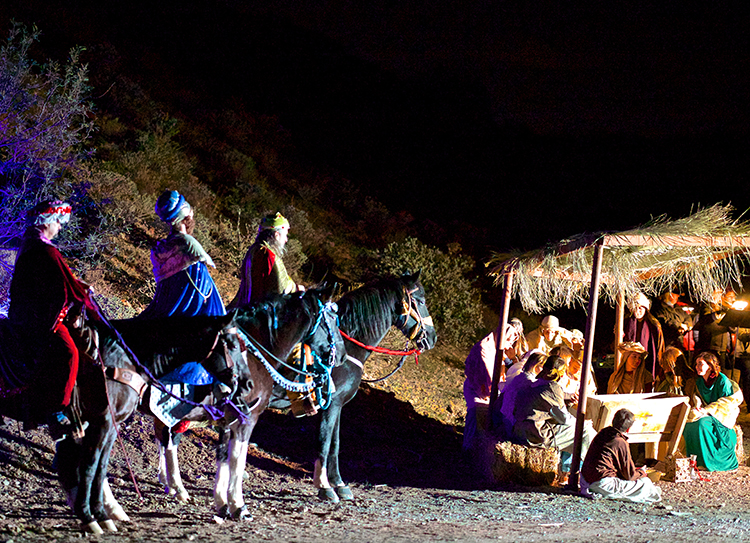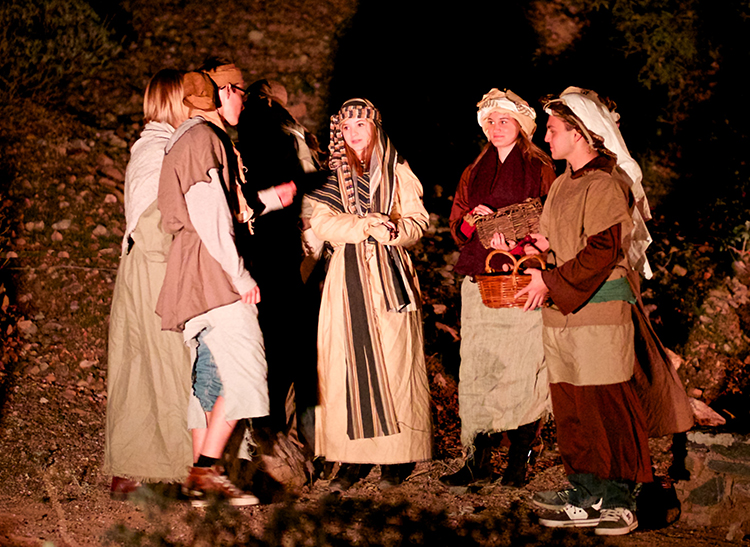Yuletides of Yesteryear

Writer Joseph J. Airdo // Photographer Herbert Hitchon
Christmas across Arizona does not look like it did a few decades ago.
As is the case with just about anything, the way we celebrate the holidays has changed quite dramatically over the years. Many cherished Christmas traditions have fallen by the wayside, paving the way for new holiday events that oftentimes stray far from the ancestral values of our state.
Having lived in New River my whole life, I have witnessed the copious changes to our North Valley communities’ Yuletide traditions over the last few decades first-hand. Memories of the down-home Christmas gathering I attended as a child at New River Station have remained the unattainable standard of celebration for which I strive each holiday season.
We jingled bells from the back of a hayride to spread holiday joy to our neighbors. There was also a visit from Santa Claus and the lighting of a little tree, around which we sang Christmas carols together as a close-knit community.
As I grew older, that simple gathering of neighbors ceased to exist. Fortunately, some long-standing holiday traditions continued—such as Christmas at the Stables, a live re-enactment of the Christmas story at a New River resident’s small ranch—and new events were introduced to occupy my attention.
But nothing has ever been able to truly take the place of that down-home Christmas gathering from my early years. Even the Outlets at Anthem’s Christmas tree lighting ceremony and Carefree Christmas Festival’s electric light parade have gotten smaller with each passing year, or have disappeared from the holiday calendar altogether.
Humble Gratitude
Arizona’s official state historian Marshall Trimble says that Christmas has gotten much more commercial than it was when he was a child eight decades ago.
“I was born in 1939 on a farm south of Tempe,” says Trimble. “Christmas was a simple affair as the Great Depression was still with us.”
Trimble recalls what few toys he received as gifts being made of wood due to use restrictions and shortages of rubber, tin and steel during World War II.
There were few radio station options and no television back then, so 24/7 Christmas music stations and holiday specials like “Rudolph the Red-Nosed Reindeer” and “Frosty the Snowman” were not yet established as the classic customs they are now.
At school, Trimble and his classmates drew names for a gift exchange with the spending limit being capped at a quarter. His school would also host a holiday program in which the children in each class would perform a Christmas song.
One of Trimble’s fondest memories is that of his family’s holiday trips to the top of Bill Williams Mountain where they cut down a small pine tree. It was an event to adorn it with decorations that they’d made themselves.
“Christmas was always lean for us,” Trimble says. “Still, I enjoyed the season. Christmas brought good cheer and hope for a better life.”
Southwestern Spirit
Arizona’s official state balladeer Dolan Ellis moved to Phoenix in 1959 from the Midwest, where Christmas celebrations were cemented in European traditions.
“I came here for the Southwestern lifestyle,” Ellis says. “I liked to attend services, missions and things like that to help me get into that to Southwestern spirit. I used to spend a lot of Christmas Eves in the desert. We would sit around a campfire in our ponchos, enjoy the sunset and eat green corn tamales.”
For a few years, Ellis even swapped out a traditional Christmas tree for a cholla cactus skeleton strung with ornaments and lights—an example of the Southwestern spirit that he believes has become somewhat of an endangered species over the years.
“I think that one of the most outstanding things that I have noticed is the disappearance of red chili pepper lights,” Ellis adds. “They used to be on every street corner in the Phoenix area around Christmas time.
“We used to hang them on our front porches and other places at Christmas as part of our holiday decorations. You still see them a lot in the Santa Fe area, but you just do not see them around here anymore.”
One Southwestern tradition that has sustained at least three decades, though, is the mysterious decoration of a small juniper tree between the northbound and southbound lanes of I-17, just north of Sunset Point.
“Someone has been sneaking out there at Christmas time for at least 30 years and decorating it for the holidays,” Ellis says. “Nobody knows who does it—and if they do, they are not talking. There have been hundreds of thousands—maybe even millions—of people who have seen that decorated tree year after year.”
The tree has become so much of a folk legend in our state that Ellis wrote a Christmas carol about it. Believing it needed a personal moniker, he named it Scrubby due to its bushy appearance, and he now sings of its tale each holiday season.
In fact, the tree has become so important to Ellis that he occasionally visits the area to water it—an especially critical undertaking after this summer’s brushfires endangered its existence.
“I just think that it is amazing that that tradition has survived through the change of culture that has happened here in Arizona,” he says. “It is really cool. I think that it is neat that whoever is doing this has carried the tradition on this long and I hope that it continues for many more years.”



A Religious Experience
Lois McFarland, a Scottsdale Historical Society Hall of Fame inductee, says that one of the most recognized holiday traditions in the history of Scottsdale is the Miracle of the Roses procession that was organized on the Saturday nearest to Dec. 12 of each year by Our Lady of Perpetual Help Catholic Church—now Old Adobe Mission.
Miracle of the Roses refers to a December 1531 event on Tepeyac Hill, Mexico when Our Lady of Guadalupe is said to have visited a humble boy. She tells him of her wish for a church to be built on the hill where she would make known her love and compassion by aiding and protecting her people.
Our Lady of Guadalupe later sent the boy to collect roses from a nearby rocky mountain—where roses had never grown before—to convince the town’s bishop of her authenticity as Mary the mother of Jesus.
“In the 1950s, the Miracle of the Roses procession began at Our Lady of Perpetual Help, honoring Our Lady of Guadalupe. Members of the Hispanic, Yaqui, Pima, Apache and Mohave communities joined in the colorful celebration,” McFarland says. “At one time, I know they ended up at Scottsdale High School—where a Christmas pageant took place.”
Unfortunately, like many other holiday traditions, the Miracle of the Roses procession ceased to exist in the 1970s due to increased traffic congestion and the advancing ages of the pageant’s performers.
The tradition was renewed—albeit smaller in scope—in 2007 after the complete restoration and reopening of Old Adobe Mission, 3817 N. Brown Ave. in Scottsdale. This year’s Miracle of the Roses event is scheduled for 4 p.m. Saturday, Dec. 14 at the church.
Nonetheless, Ellis sees a decrease in the number of Nativity scenes and religious events like the Miracle of the Roses procession also being evident of our state’s cultural shift, although he acknowledges the rest of the country shares that symptom.
“But I think it reflects differently here because of the Hispanic influence and Catholicism being so important to Arizona’s traditional culture,” Ellis adds. “Nativity scenes used to be on a lot of lawns but you just do not see them that much anymore.”
A Tradition Endures
Some Valley Yuletide traditions have beaten the odds and survived through the decades, though, with the Desert Foothills Christmas Pageant—scheduled this year for 7 p.m. Dec. 7 and 8—also proving that humble gratitude, Southwestern spirit and religion continue to play a big part in Arizona’s holiday celebrations.
The Desert Foothills Christmas Pageant is a non-denominational re-enactment of the Christmas story that is presented by Cactus Shadows High School thespians in a rural area of Cave Creek near Spur Cross Ranch.
Cave Creek’s 4H Club hosted the first Desert Foothills Christmas Pageant, then titled Oh Holy Night, in 1952. The original production took place among the rocks at the base of Black Mountain in an area known as Tse Bonita.
The 4H Club eventually passed the baton to another association that supported the event until it disbanded in 2002. With no one willing to take it over, it appeared as though the Desert Foothills Christmas Pageant would go the way of so many of Arizona’s other cherished holiday traditions. Records and memorabilia were handed over to the Cave Creek Museum to rest alongside the many other relics of yesteryear.
However, two years later, Cave Creek resident Toby Payne asked Foothills Community Foundation to support the resurrection of the pageant. He had been a volunteer for the event since 1992, enhancing it with lighting and sound. The foundation agreed and the Desert Foothills Christmas Pageant once again became a part of the community’s holiday festivities.
“It is what was created 67 years ago,” Payne says. “The angels are on top of a mountain, the kings ride in on horseback, there is a live choir and the script is the same one that we have used for at least 35 years.
“We have fourth-generation people now involved in helping to preserve it. We have people who have continued to be in it as well as people who have gotten their own families and now have children in it. You get a lot of holiday events that start up and go a few years, but this Christmas tradition has continued all this time.”

